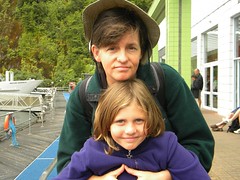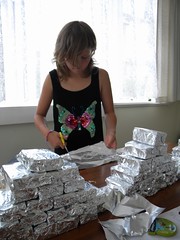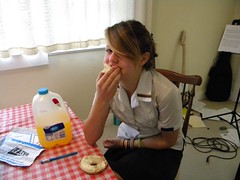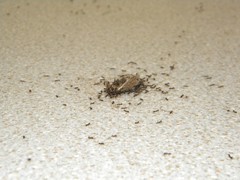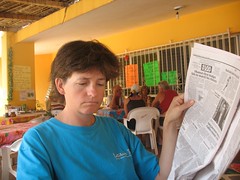The pattern for transition panic attacks is well established now. DrC and I have some brilliant idea to completely rewrite the script of our lives. We plan, we research, we invest, we organize, coordinate, and delegate. I put all the tasks into my handy dandy trusted getting things done software. We start down the path of ticking off our to do items one by one. It all goes swimmingly.
For months.
Then we start to approach a critical date. The date could be called “cutting the lines.” It’s the day we leave this and go to that. This. Now That. This... this no more. Now THAT. That date gets closer and my lizard brain begins to make itself felt.
It starts with short temper and a tendency to take even the most minor project and divide into a dozen or more separate tasks. It is during this phase that I come closest to breaking my poor beleaguered Mac and the cutesy little database application I’m using to organize this insanity. As an example, this phase involves my breaking down sell the beds into: select the items, clean up the items, take a picture, post the picture, post the trade, track the trade, respond to inquiries, verify sale, verify deposit, organize pick up of item, remove project from database. The day that iGTD stops backing up, coughs up a furball, chokes and loses two hours worth of entries is the day I know I’ve moved into the next phase.
During phase two I work my ass off. I actively seek new clients, pull up business contacts from decades ago, and volunteer for open source projects. I scrub the freezer out with a toothbrush and polish all the silver. I invent problems. I invent them, diagnose them, solve them preemptively, and scare the hell out of DrC and the girls when I explain the whole averted disaster scenario thwarted only due to my hyper active, prescient intervention.
Phase three begins the first night I wake up in a cold sweat unable to breathe. After doing this three times in five years, I now can actually mark this milestone on my calendar with the clear recognition it means that we are approximately three weeks from The Date. In fact, I knew it was three weeks before I was to officiate at a good friend’s wedding last spring, because I woke up unexpectedly in one of these blinding panics. In that case, it was a single event, important, emotional and tremendous to my spirit, but the kids and DrC were going to be safe at home as were all my worldly goods. I was able to talk myself down from the rafters and get some sleep.
With the hemisperical moves, however, when I am putting our entire lives into a dozen suitcases and shifting us halfway around the world, no amount of soothing self-chatter calms me down. Unless I want to drag DrC into my 2am pit of black angst and woe, I have to get up, shlep into the kitchen, and Do Something Constructive. Sometimes I write blog posts, sometimes I drink a half box of red wine, sometimes I do both. I’m not going to say this hasn’t had a deleterious effect on the quality of my blog posts, but it is doing wonders for the quantity.
In the final days before The Date, I can be a supreme bitch. I can be the meanest, most heinous, sharpest, nastiest witch ever. I say that with the assurance of one who actually has been that person. But not this time.
Not this time because this time we all know the signs, the symptoms, the causes. DrC and the girls and I all see Super Bitch on the horizon. I’m working very hard to head her off, distract her, fill her days and her nights with anything but terror. The girls are stepping up like the amazing troopers they are: packing, organizing, inventorying, brainstorming, and just plain staying out of sight. DrC rubs my back at night, makes sure the wine and beer are stocked, and doesn’t ask me why I wasn’t in bed all night. He’s patient when I talk for hours about this and that detail, actually giving the illusion he’s paying attention as we review my GTD task list each week.
SB is still here in the house. I think I can smell her, a combination of stale fear sweat and chili farts. I’m just going to put her in the same category as the ants, the cat piss, the sweating walls, and the broken fridge as just one more reason to be ecstatic we are finally leaving Chicken House.
Sunday, January 23, 2011
Sunday, January 09, 2011
Curriculum 2011
Every year it gets a bit more challenging to homeschool the girls while it simultaneously gets much easier. After a year languishing in what passes for education here in Pukekohe, the girls have to get back to work.
2010 was a very enjoyable but essentially academically null year. #2 and #3 at least loved their school, respected their teachers, and learned how to reach out to children their own age. Aeron was her bouncy, generous, friendly self while reserved Mera nevertheless found ways to make connections. In particularly, Mera's experience of Kapa Haka was so positive that it would have served alone to make the school year worthwhile.
But I digress, we are talking about "Homeschooling: The Later Years." What gets easier is teaching our children. The unschoolers are essentially correct when they say that kids are information sponges when left to their own devices. Educating the girls grew easier and easier the less effort we put into it and the more we let them do it themselves. At this point, we simply put the content in their hands, set minimum targets for volume, and then let them have at it. Generally, they limp along grudgingly in topics of less interest while blowing out the targets when something engages.
Yet, there is the kernel of the problem as well. As the girls get older it gets harder to find good, self-guided instructional material... at an affordable cost. During the younger years, we relied heavily on workbooks. Workbooks were available in all subjects at the local children's educational book shop for quite reasonable prices. If we couldn't find it there, we could always go straight to the publisher and purchase our pick of workbooks in the $15 to $25 range.
The workbooks, however, start fading in about middle school and are essentially gone by high school. That's a shame because workbooks are a fantastically useful teaching tool at any age. In their place are $100 to $200 middle, high school, and college text books. When your student doesn't click with a $15 geography workbook, you try a different author or publisher. When she throws up her hands at a $100 textbook, it's tempting to bash her over the head with it.
Another problem we face as the girls get older is that they are starting to have Goals. It used to be we could select the books, the balance of one subject versus the next, and the volume and pacing with almost no input from the children. Sure, occasionally a book or program died in their hands and required replacement; Singapore Math and Calvert both immediately leap to mind. We listened and replaced, but we didn't really abandon the principle of, “Yes child... math is something we're going to master, as are spelling, writing, and science.” It's not like we ignored them, but unless the book or exercise was completely heinous (e.g. Elements of Language 1, 2 and 3), they didn't care much one way or another what we swapped out.
But now, there is a Plan. Jaime in particular has narrowly defined aspirations; Her current career objective is to become a Civil Engineer. The only question is which flavor, but the basics requirements are the same. To the end of getting admitted to a New Zealand, Australian, or U.K. University in the field, she presented me with a laundry list of subjects she wishes to study during our 2011 homeschool year. These include: Physics (NCEA 2), Statistics/Modeling, Economics, Chemistry (NCEA2), and Geoscience. I talked her into an art class only, but only after I found a really good textbook on Basic Technical Drawing. It took a visit to the iCivilEngineering web site to convince her that a computer class was essential; So we're also tackling AutoCAD next year. The later effort also required a bribe of fixing her laptop keyboard and an iTunes gift certificate. It took her father's intervention to drag her kicking and screaming into agreeing to a literature and writing survey course which he'll be conducting with Mera. God forbid we spend even a moment reading and savoring the classics. This will teach me to let my daughters hang out with engineering geeks.
Mera's goals are less well formed. However, her critical opinion on topics and materials are considerably better articulated and delivered with a cool disdain when I somehow fail to meet her educational expectations. The literature course spearheaded by her father includes a reading list which required considerable massaging before attaining her coveted approval. She flat out veto'ed our grammar tomes and writing exercise books as both “poorly written” and “utterly useless.” And despite the fact that her mother is a professional technical writer, her father an English graduate from U.C. Berkeley, she requested that her Grandmother Nancy take responsibility for evaluating her non-fiction, Grandma Sue the fiction. She deigns to learn Science and Spanish from her father, Math from her mother, but she will teach herself Drawing, Music, and History thank you very much.
Thank all the little gods of parenting, Aeron still doesn't care.
We are hundreds of dollars into this project of School 2011. The books we've ordered are gathering at Chicken House and in the States at my mother's house. We will have no opportunity to swap out topics or texts once we leave the coast of Mexico. Our principle consolation is that old standby of cruising families everywhere. Even if they fail at homeschool, the Experience Will Educate Them. Surprisingly, this isn't sophistry. Just look at the girls' accomplishments in New Zealand. No question that somehow, some way, we are keeping up with the educational jones.
2010 was a very enjoyable but essentially academically null year. #2 and #3 at least loved their school, respected their teachers, and learned how to reach out to children their own age. Aeron was her bouncy, generous, friendly self while reserved Mera nevertheless found ways to make connections. In particularly, Mera's experience of Kapa Haka was so positive that it would have served alone to make the school year worthwhile.
But I digress, we are talking about "Homeschooling: The Later Years." What gets easier is teaching our children. The unschoolers are essentially correct when they say that kids are information sponges when left to their own devices. Educating the girls grew easier and easier the less effort we put into it and the more we let them do it themselves. At this point, we simply put the content in their hands, set minimum targets for volume, and then let them have at it. Generally, they limp along grudgingly in topics of less interest while blowing out the targets when something engages.
Yet, there is the kernel of the problem as well. As the girls get older it gets harder to find good, self-guided instructional material... at an affordable cost. During the younger years, we relied heavily on workbooks. Workbooks were available in all subjects at the local children's educational book shop for quite reasonable prices. If we couldn't find it there, we could always go straight to the publisher and purchase our pick of workbooks in the $15 to $25 range.
The workbooks, however, start fading in about middle school and are essentially gone by high school. That's a shame because workbooks are a fantastically useful teaching tool at any age. In their place are $100 to $200 middle, high school, and college text books. When your student doesn't click with a $15 geography workbook, you try a different author or publisher. When she throws up her hands at a $100 textbook, it's tempting to bash her over the head with it.
Another problem we face as the girls get older is that they are starting to have Goals. It used to be we could select the books, the balance of one subject versus the next, and the volume and pacing with almost no input from the children. Sure, occasionally a book or program died in their hands and required replacement; Singapore Math and Calvert both immediately leap to mind. We listened and replaced, but we didn't really abandon the principle of, “Yes child... math is something we're going to master, as are spelling, writing, and science.” It's not like we ignored them, but unless the book or exercise was completely heinous (e.g. Elements of Language 1, 2 and 3), they didn't care much one way or another what we swapped out.
But now, there is a Plan. Jaime in particular has narrowly defined aspirations; Her current career objective is to become a Civil Engineer. The only question is which flavor, but the basics requirements are the same. To the end of getting admitted to a New Zealand, Australian, or U.K. University in the field, she presented me with a laundry list of subjects she wishes to study during our 2011 homeschool year. These include: Physics (NCEA 2), Statistics/Modeling, Economics, Chemistry (NCEA2), and Geoscience. I talked her into an art class only, but only after I found a really good textbook on Basic Technical Drawing. It took a visit to the iCivilEngineering web site to convince her that a computer class was essential; So we're also tackling AutoCAD next year. The later effort also required a bribe of fixing her laptop keyboard and an iTunes gift certificate. It took her father's intervention to drag her kicking and screaming into agreeing to a literature and writing survey course which he'll be conducting with Mera. God forbid we spend even a moment reading and savoring the classics. This will teach me to let my daughters hang out with engineering geeks.
Mera's goals are less well formed. However, her critical opinion on topics and materials are considerably better articulated and delivered with a cool disdain when I somehow fail to meet her educational expectations. The literature course spearheaded by her father includes a reading list which required considerable massaging before attaining her coveted approval. She flat out veto'ed our grammar tomes and writing exercise books as both “poorly written” and “utterly useless.” And despite the fact that her mother is a professional technical writer, her father an English graduate from U.C. Berkeley, she requested that her Grandmother Nancy take responsibility for evaluating her non-fiction, Grandma Sue the fiction. She deigns to learn Science and Spanish from her father, Math from her mother, but she will teach herself Drawing, Music, and History thank you very much.
Thank all the little gods of parenting, Aeron still doesn't care.
We are hundreds of dollars into this project of School 2011. The books we've ordered are gathering at Chicken House and in the States at my mother's house. We will have no opportunity to swap out topics or texts once we leave the coast of Mexico. Our principle consolation is that old standby of cruising families everywhere. Even if they fail at homeschool, the Experience Will Educate Them. Surprisingly, this isn't sophistry. Just look at the girls' accomplishments in New Zealand. No question that somehow, some way, we are keeping up with the educational jones.
Wednesday, January 05, 2011
Follow the Trail
I look around the disaster zone which is my daughters' dorm room and ask my husband, “They're joking, right?”
He shakes his head: sad, frustrated, mad. “I don't think so.”
It's Sunday. Sunday at Chicken House is a Day of Work. We take this weekly opportunity to clean the house from end to end, load up the pantry with groceries, engage in serious, hard-core exercise, and study study study. I don't know that we ever consciously set out to position ourselves 180 degrees from our Christian neighbors and friends, but it's not an unhappy coincidence. There is an agreement that in addition to the toilet, shower, kitchen floor, and laundry, everyone is also required to straighten up their personal space with an eye towards removing every possible temptation to the local ant population. So DrC and I are standing, fists clenched tightly and propped aggressively on hips, to survey the results of their effort to achieve a Minimum Standard of Cleanliness.
DrC and I are not unreasonable in our fanatic insistence on cleanliness. Our concern is not founded in anything as silly as a fear of germs and bacteria; We actually welcome challenges to our immune system in the form of random strangers, poor personal hygiene, and water from suspect sources. The problem is Chicken House.
Chicken House is constructed on top of an enormous infestation of alien attack ants. These mutant black creatures have the ability to detect microscopic bits of pain au chocolate and honey drips, establishing a one inch wide trail stretching from the back door, down the hall to the living room, up on to the coffee table, over a casually draped jumper, and directly to a chunk of scone lodged in the starboard couch cushion. I sit down in the morning to finish my latte and grind my inbox down to zero. When I glance up a few minutes later, the kitchen counters are literally awash in a roiling mass of small dark invaders. They know our house schedule, architectural inadequacies, and eating habits with Google-level privacy invasion precision. If we wait patiently enough, I know eventually we'll catch the Ant Street View vehicles roaming the house snapping 360 pictures of everything we own. I'm hoping I'm not naked at the time.
Do not under any circumstances protest that ants are not sentient. If you can say that with a straight face, you've never lived with ants. Ants know all, see all. They are more clever and more ubiquitous than any omniscient deity. Like human babies, they can defy physical law and pass through openings that are considerably smaller than themselves. Ants are adaptive – block their entrance with poison gas or paprika, chewing gum or bait traps, and your average ant community will reroute faster than Internet backbone servers.
Ants are also stubborn, even more stubborn than teenagers. Our ants – and I say “our” with no small degree of irony – refuse to give up their basic contention that Chicken House and all its contents belong to the Ants. Like college roommates, what is mine is mine and what is yours is mine. It's not enough that we carefully compile all our vegie scraps into a bucket and pile it in the backyard for composting providing an endless source of food. No, it's also necessary to drink our last beer, eat the last batch of microwave popcorn, and borrow our last clean towel.... ant-iphorically speaking.
All winter long we've waged urban warfare against the ants, attempting to create safe zones within Chicken House. While conceding to the complete lawlessness of the kitchen wherein we just hope to eat our meal fast enough that it doesn't get carried away, we have been able to fight the ants back in the parental bedroom, my office, and the rooms which serve the bath, toilet, and shower. The living room and kid dorm, however, are a standing source of extreme familial strife. On the one side are parental edicts: no eating, no dishes, no candy, no cookies, nothing edible period no exceptions ever. On the other side is childhood rebellion.
So the ants are winning.
He shakes his head: sad, frustrated, mad. “I don't think so.”
It's Sunday. Sunday at Chicken House is a Day of Work. We take this weekly opportunity to clean the house from end to end, load up the pantry with groceries, engage in serious, hard-core exercise, and study study study. I don't know that we ever consciously set out to position ourselves 180 degrees from our Christian neighbors and friends, but it's not an unhappy coincidence. There is an agreement that in addition to the toilet, shower, kitchen floor, and laundry, everyone is also required to straighten up their personal space with an eye towards removing every possible temptation to the local ant population. So DrC and I are standing, fists clenched tightly and propped aggressively on hips, to survey the results of their effort to achieve a Minimum Standard of Cleanliness.
DrC and I are not unreasonable in our fanatic insistence on cleanliness. Our concern is not founded in anything as silly as a fear of germs and bacteria; We actually welcome challenges to our immune system in the form of random strangers, poor personal hygiene, and water from suspect sources. The problem is Chicken House.
Chicken House is constructed on top of an enormous infestation of alien attack ants. These mutant black creatures have the ability to detect microscopic bits of pain au chocolate and honey drips, establishing a one inch wide trail stretching from the back door, down the hall to the living room, up on to the coffee table, over a casually draped jumper, and directly to a chunk of scone lodged in the starboard couch cushion. I sit down in the morning to finish my latte and grind my inbox down to zero. When I glance up a few minutes later, the kitchen counters are literally awash in a roiling mass of small dark invaders. They know our house schedule, architectural inadequacies, and eating habits with Google-level privacy invasion precision. If we wait patiently enough, I know eventually we'll catch the Ant Street View vehicles roaming the house snapping 360 pictures of everything we own. I'm hoping I'm not naked at the time.
Do not under any circumstances protest that ants are not sentient. If you can say that with a straight face, you've never lived with ants. Ants know all, see all. They are more clever and more ubiquitous than any omniscient deity. Like human babies, they can defy physical law and pass through openings that are considerably smaller than themselves. Ants are adaptive – block their entrance with poison gas or paprika, chewing gum or bait traps, and your average ant community will reroute faster than Internet backbone servers.
Ants are also stubborn, even more stubborn than teenagers. Our ants – and I say “our” with no small degree of irony – refuse to give up their basic contention that Chicken House and all its contents belong to the Ants. Like college roommates, what is mine is mine and what is yours is mine. It's not enough that we carefully compile all our vegie scraps into a bucket and pile it in the backyard for composting providing an endless source of food. No, it's also necessary to drink our last beer, eat the last batch of microwave popcorn, and borrow our last clean towel.... ant-iphorically speaking.
All winter long we've waged urban warfare against the ants, attempting to create safe zones within Chicken House. While conceding to the complete lawlessness of the kitchen wherein we just hope to eat our meal fast enough that it doesn't get carried away, we have been able to fight the ants back in the parental bedroom, my office, and the rooms which serve the bath, toilet, and shower. The living room and kid dorm, however, are a standing source of extreme familial strife. On the one side are parental edicts: no eating, no dishes, no candy, no cookies, nothing edible period no exceptions ever. On the other side is childhood rebellion.
So the ants are winning.
Saturday, January 01, 2011
Communication on the High Seas (Part 2)
“Is that French?”
“Yeah, but I think it's Canada. Don't get excited. We're not there yet.”
~ dialog between two cruisers halfway from Mexico to French Polynesia
In Part 1 of this series about Communicating on the High Seas, I talked about VHF. While good for short range, VHF is seriously hampered by distance and physical obstacles such as mountains, buildings, and cruise ships. For long range, we rely on our SSB.
Single Side Band (SSB) radio seems like an expensive and persnickity technology to add to your boat. I readily admit that for weekend cruisers – perhaps even for coastal cruising – an SSB isn't really a critical necessity. If you rarely leave sight of land and that land is the U.S., Canada, or other countries with extremely well deployed and powerful marine VHF radio networks, you can forego the hassle and expense. On the other hand, an SSB brings a few really nice advantages to the boat that even in the Pacific Northwest and Mexico, we on Don Quixote were very glad to have. For those planning longer, transoceanic journies, an SSB is about as non-optional a piece of equipment as radar.
Our ICOM802 has proven a solid, reliable addition to the boat. Other cruisers will swear by their brand or model. I can't speak to the comparative value in SSB models. I just know two really important bits about Don Quixote's radio:
It works.
It is load.
Loud in SSB terms is a Good Thing. Generally, it means that the unit is well-powered, the settings are configured correctly, and – probably most importantly – the unit is grounded properly and has a well founded antenna. Folks troubleshooting SSB radios say that grounding and antenna are the two most common issues with these units. I can't tell you how many stories we've heard about $1000 electronic paperweights revived by changing the connections someplace deep in the bowels of the boat. Troubleshooting an SSB is about the fastest way to go mad on a boat as comes immediately to mind.
Because of these known issues, DrC took two measures which he offers on the off chance that one or both are the magical sauce which blessed us with a loud SSB:
Copper Foil – He lined the entire port bilge with copper foil and connected it to the SSB ground.
Split Lead Antenna - I'll defer to Panbo this subject. DrC installed an Gam split lead antenna on the port side spreader. Again, don't know why or how, but our system works. This could be the mojo.
Now that you have an SSB, some pro with squinty eyes and leather skin installed it, and you've copper-plated the hull, let's talk about why an SSB is a must-have on Don Quixote.
Weather – You North Americans are so spoiled. I remember the days when we could just tune the VHF to the US or Canadian weather channel and get an up-to-date report on weather conditions. Not so much any place else. I bet Europe broadcasts weather, too... probably other folks as well. Mexico doesn't bother – even assuming you speak Spanish well enough to understand it – and obviously no one is keeping station in the middle of the Pacific. Fortunately, pretty much every report, fax, GRIB, and weather service is available over the SSB. What doesn't publish directly over the radio waves, you can subscribe to indirectly via a mail service such as WinLink or SailMail.
Email – Which gets me to my favorite SSB feature, electronic messaging. Drop yourself mentally back to the days of 2400 baud dial-up modems, and you can honestly say that your boat has “access” to the Internet. Text only, true. Yet, do not discount how useful it is to exchange messages with family, destination contacts, and the world. If you're clever, you can set up your blog, Facebook account, Twitter, and other social media to accept content from your SSB address, enabling you to continue to broadcast the contents of your lunch to all and sundry from the middle of nowhere.
Cruiser Nets – Everywhere we've been or plan to visit, we have been able to participate in regular cruiser nets. These daily events serve cruisers as combined weather report, social opportunity, and safety net. Cruisers exchange information on conditions, arrange meetups, and coordinate passages. Where we personally found a net the most useful was during the hurricane season in the Sea of Cortez. However, Pacific Puddle Jumpers from prior years report that the PPJ net will become our lifeline during our months on the Coconut Milk Run. It surprises us not at all, and we're looking forward to sharing our experiences over the airwaves with our fellow jumpers.
Entertainment – And if all that were insufficient to convince you of the usefulness of an SSB, you can always listen to the radio as … yes... a radio. If you really want to listen to the news, you can. If you really want to.
“Yeah, but I think it's Canada. Don't get excited. We're not there yet.”
~ dialog between two cruisers halfway from Mexico to French Polynesia
In Part 1 of this series about Communicating on the High Seas, I talked about VHF. While good for short range, VHF is seriously hampered by distance and physical obstacles such as mountains, buildings, and cruise ships. For long range, we rely on our SSB.
Single Side Band (SSB) radio seems like an expensive and persnickity technology to add to your boat. I readily admit that for weekend cruisers – perhaps even for coastal cruising – an SSB isn't really a critical necessity. If you rarely leave sight of land and that land is the U.S., Canada, or other countries with extremely well deployed and powerful marine VHF radio networks, you can forego the hassle and expense. On the other hand, an SSB brings a few really nice advantages to the boat that even in the Pacific Northwest and Mexico, we on Don Quixote were very glad to have. For those planning longer, transoceanic journies, an SSB is about as non-optional a piece of equipment as radar.
Our ICOM802 has proven a solid, reliable addition to the boat. Other cruisers will swear by their brand or model. I can't speak to the comparative value in SSB models. I just know two really important bits about Don Quixote's radio:
It works.
It is load.
Loud in SSB terms is a Good Thing. Generally, it means that the unit is well-powered, the settings are configured correctly, and – probably most importantly – the unit is grounded properly and has a well founded antenna. Folks troubleshooting SSB radios say that grounding and antenna are the two most common issues with these units. I can't tell you how many stories we've heard about $1000 electronic paperweights revived by changing the connections someplace deep in the bowels of the boat. Troubleshooting an SSB is about the fastest way to go mad on a boat as comes immediately to mind.
Because of these known issues, DrC took two measures which he offers on the off chance that one or both are the magical sauce which blessed us with a loud SSB:
Copper Foil – He lined the entire port bilge with copper foil and connected it to the SSB ground.
Split Lead Antenna - I'll defer to Panbo this subject. DrC installed an Gam split lead antenna on the port side spreader. Again, don't know why or how, but our system works. This could be the mojo.
Now that you have an SSB, some pro with squinty eyes and leather skin installed it, and you've copper-plated the hull, let's talk about why an SSB is a must-have on Don Quixote.
Weather – You North Americans are so spoiled. I remember the days when we could just tune the VHF to the US or Canadian weather channel and get an up-to-date report on weather conditions. Not so much any place else. I bet Europe broadcasts weather, too... probably other folks as well. Mexico doesn't bother – even assuming you speak Spanish well enough to understand it – and obviously no one is keeping station in the middle of the Pacific. Fortunately, pretty much every report, fax, GRIB, and weather service is available over the SSB. What doesn't publish directly over the radio waves, you can subscribe to indirectly via a mail service such as WinLink or SailMail.
Email – Which gets me to my favorite SSB feature, electronic messaging. Drop yourself mentally back to the days of 2400 baud dial-up modems, and you can honestly say that your boat has “access” to the Internet. Text only, true. Yet, do not discount how useful it is to exchange messages with family, destination contacts, and the world. If you're clever, you can set up your blog, Facebook account, Twitter, and other social media to accept content from your SSB address, enabling you to continue to broadcast the contents of your lunch to all and sundry from the middle of nowhere.
Cruiser Nets – Everywhere we've been or plan to visit, we have been able to participate in regular cruiser nets. These daily events serve cruisers as combined weather report, social opportunity, and safety net. Cruisers exchange information on conditions, arrange meetups, and coordinate passages. Where we personally found a net the most useful was during the hurricane season in the Sea of Cortez. However, Pacific Puddle Jumpers from prior years report that the PPJ net will become our lifeline during our months on the Coconut Milk Run. It surprises us not at all, and we're looking forward to sharing our experiences over the airwaves with our fellow jumpers.
Entertainment – And if all that were insufficient to convince you of the usefulness of an SSB, you can always listen to the radio as … yes... a radio. If you really want to listen to the news, you can. If you really want to.
Subscribe to:
Comments (Atom)

